Soil Mercury Pollution of Hainan Island, China: Patterns, Influencing Factors, and Health Risks
Abstract
1. Introduction
2. Study Area
3. Materials and Methods
3.1. Sampling and Analysis
3.1.1. Sampling and Analysis of Soil Hg
3.1.2. Determination of Total Atmospheric Hg
3.2. Methodology
3.2.1. Evaluation of Soil Hg Pollution
3.2.2. Health Risk Assessment of Soil Hg
4. Results and Discussion
4.1. Factors Affecting Soil Hg Levels
4.1.1. Distribution Characteristics of Soil Hg Levels
4.1.2. Impact of Wind Direction on Soil Hg
4.1.3. Relationship between Soil Hg and Atmospheric Hg
4.2. Hg Pollution Assessment
4.2.1. Soil Hg Pollution Assessment
4.2.2. Soil Hg Health Risk Assessment
4.2.3. Hg Pollution Control and Prevention
- Long-Term Monitoring: Establish a comprehensive network for monitoring Hg pollution, including Hg sources and key sites to timely assess the status of Hg pollution.
- Discharge Restrictions: Enforce limits on Hg emissions in industrial activities, including mining, by employing advanced technology and equipment to minimize the release of Hg. Additionally, enhance the control of Hg emissions from coal-fired enterprises by implementing technologies such as clean coal combustion and flue gas desulfurization and denitrification.
- Waste Treatment: Employ suitable technologies for treating waste containing Hg, including recycling, transformation, and safe disposal.
- Management and Control: Enhance prudent use and management of Hg, promote its recycling and reutilization, and minimize its use and release. Strengthen the supervision of mining enterprises, preventing illegal discharge of Hg-containing waste water and solid waste.
5. Conclusions
- (1)
- The soil Hg content in Hainan Island ranges from 6.04 to 1582.50 ng·g−1, with an average of 61.51 ng·g−1. There are significant regional differences. Changjiang Li Autonomous County (NW), which is rich in mineral resources, showed the highest concentration, ranging from 10.00 to 1582.50 ng·g−1, with an average of 61.51 ng·g−1. This was followed by the economically developed cities of Haikou (NE) and Sanya (S), with soil Hg concentrations of 8.33–321.50 ng·g−1 and 6.04–180.50 ng·g−1, respectively, and averages of 54.01 ng·g−1 and 41.08 ng·g−1, respectively. Wuzhishan Nature Reserve (B) and Lingshui Li Autonomous County (SE) have the lowest concentrations, i.e., 10.70–104.67 ng·g−1 and 9.43–84.00 ng·g−1, respectively, with averages of 32.67 ng·g−1 and 26.96 ng·g−1, respectively.
- (2)
- Wind direction significantly influences soil Hg content, with higher levels in the downwind (NW) compared to the upwind (SE) regions. A strong positive correlation is found between the atmospheric Hg concentrations at ground surface and 100 cm above the ground, whereas an insignificant correlation exists between the contents of soil Hg and atmospheric Hg at ground surface.
- (3)
- According to the analysis of the Single Pollution Index and the Geo-accumulation Index, 55.23% and 30.96% of the sampling sites have Hg pollution, with the NE and S areas showing the highest concentration, followed by the NW area. The SE area exhibits the lowest level of Hg pollution, in which most of the sampling sites exhibit moderate pollution, with a smaller number showing strong pollution. The Single Pollution Index method reveals 18 strongly polluted sampling sites, primarily concentrated in the NW and NE regions. In contrast, the Geo-accumulation Index method indicates only 4 strongly polluted sampling sites, all of which are located in the NW regions.
- (4)
- The health risk assessment indicates that the current risk index of Hg pollution in Hainan Island ranges from 0.0001 to 0.0334. The pollution level is insufficient to pose a non-carcinogenic risk to human health. Nevertheless, continuous monitoring and health risk assessments of soil Hg concentrations are necessary due to the rapid expansion of transportation, mining, and industrialization.
Supplementary Materials
Author Contributions
Funding
Institutional Review Board Statement
Informed Consent Statement
Data Availability Statement
Acknowledgments
Conflicts of Interest
References
- Meriga, B.; Krishna Reddy, B.; Rajender Rao, K.; Ananda Reddy, L.; Kavi Kishor, P.B. Aluminum-induced production of oxygen radicals, lipid peroxidation and DNA damage in seedlings of rice (Oryza sativa). J. Plant Physiol. 2004, 161, 63–68. [Google Scholar] [CrossRef] [PubMed]
- Futsaeter, G.; Wilson, S. The UNEP global Hg assessment: Sources, emissions and transport. In Proceedings of the 16th International Conference on Heavy Metals in the Environment, Rome, Italy, 23–27 September 2012; pp. 973–974. [Google Scholar]
- Carocci, A.; Rovito, N.; Sinicropi, M.S.; Genchi, G. Mercury Toxicity and Neurodegenerative Effects. In Reviews of Environmental Contamination and Toxicology; Whitacre, D., Ed.; Reviews of Environmental Contamination and Toxicology; Springer: Cham, Switzerland, 2014; Volume 229, pp. 1–18. [Google Scholar] [CrossRef]
- Bolaños-Alvarez, Y.; Ruiz-Fernández, A.C.; Sanchez-Cabeza, J.A.; Asencio, M.D.; Espinosa, L.F.; Parra, J.P.; Garay, J.; Delanoy, R.; Solares, N.; Montenegro, K.; et al. Regional assessment of the historical trends of Hg in sediment cores from Wider Caribbean coastal environments. Sci. Total Environ. 2024, 2024, 170609. [Google Scholar] [CrossRef]
- Cheng, P.L. The sociological research on “Minamata Disease” in Japan. J. Hohai Univ. Philos. Social Sci. 2008, 10, 30–33, (In Chinese with English Abstract). [Google Scholar]
- Taylor, J. Hg reduction efforts in Michigan. Fuel Process. Technol. 2000, 60, 69–77. [Google Scholar] [CrossRef]
- Martin, L.; Pekka, N.; Sirkka-Liisa, N. Uptake of Hg by terrestrial plants-observations in Fin-land and Slovenia in the years 1979~1981. Mater. Geoenviron. 2004, 51, 1181–1184. [Google Scholar]
- Hu, Y. Reviews of Hg pollution distribution status research at home and abroad. Environ. Prot. Sci. 2008, 34, 38–41, (In Chinese with English Abstract). [Google Scholar]
- Dai, L.; Zhang, B.; Liao, X.; Wang, L.; Zhang, Q.; Tian, S.; Liang, T.; O’Connor, D.; Rinklebe, J. Catchment land use effect on Hg concentrations in lake sediments: A high-resolution study of Qinghai Lake. Sci. Total Environ. 2024, 916, 170260. [Google Scholar] [CrossRef]
- Kang, H.; Liu, X.; Guo, J.; Xu, G.; Wu, G.; Zeng, X.; Wang, B.; Kang, S. Increased Hg pollution revealed by tree rings from the China’s Tianshan Mountains. Sci. Bull. 2018, 63, 1328–1331. [Google Scholar] [CrossRef]
- Driscoll, C.T.; Mason, R.P.; Chan, H.M.; Jacob, D.J.; Pirrone, N. Hg as a global pollutant: Sources, pathways, and effects. Environ. Sci. Technol. 2013, 47, 4967–4983. [Google Scholar] [CrossRef]
- Wang, X.; Yuan, W.; Lin, C.J.; Zhang, L.M.; Feng, X.B. Climate and vegetation as primary drivers for global Hg storage in surface soil. Environ. Sci. Technol. 2019, 53, 10665–10675. [Google Scholar] [CrossRef]
- Song, Z.; Wang, C.; Ding, L.; Chen, M.; Hu, Y.; Li, P.; Zhang, L.; Feng, X. Soil Hg pollution caused by typical anthropogenic sources in China: Evidence from stable Hg isotope measurement and receptor model analysis. J. Clean. Prod. 2021, 288, 125687. [Google Scholar] [CrossRef]
- Yin, W.; Lu, Y.; Li, L.; Chen, C.; Zhang, C.; Dong, F. Distribution characteristics and pollution assessment of Hg in urban soils of Guangzhou. Chin. J. Soil Sci. 2009, 40, 1185–1188, (In Chinese with English Abstract). [Google Scholar]
- Lindberg, S.; Bullock, R.; Ebinghaus, R.; Engstrom, D.; Feng, X.; Fitzgerald, W.; Pirrone, N.; Prestbo, E.; Seigneur, C. A synthesis of progress and uncertainties in attributing the sources of Hg in deposition. AMBIO A J. Hum. Environ. 2007, 36, 19–33. [Google Scholar] [CrossRef]
- Xu, J.; Bravo, A.G.; Lagerkvist, A.; Bertilsson, S.; Sjöblom, R.; Kumpiene, J. Sources and remediation techniques for Hg contaminated soil. Environ. Int. 2015, 74, 42–53. [Google Scholar] [CrossRef] [PubMed]
- Zhang, J.; Xu, Y.; Wu, Y.; Hu, S.; Zhang, Y. Dynamic characteristics of heavy metal accumulation in the farmland soil over Xiaoqinling gold-mining region, Shaanxi. China Environ. Earth Sci. 2019, 78, 25. [Google Scholar] [CrossRef]
- Corella, J.P.; Sierra, M.J.; Garralón, A.; Millán, R.; Rodríguez-Alonso, J.; Mata, M.P.; de Vera, A.V.; Moreno, A.; González-Sampériz, P.; Duval, B.; et al. Recent and historical pollution legacy in high altitude Lake Marboré (Central Pyrenees): A record of mining and smelting since pre-Roman times in the Iberian Peninsula. Sci. Total Environ. 2021, 751, 141557. [Google Scholar] [CrossRef]
- Duval, B.; Tessier, E.; Kortazar, L.; Fernandez, L.A.; de Diego, A.; Amouroux, D. Dynamics, distribution, and transformations of Hg species from pyrenean high-altitude lakes. Environ. Res. 2023, 216, 114611. [Google Scholar] [CrossRef]
- Fang, F.; Wang, Q.; Li, J. Urban environmental Hg in Changchun, a metropolitan city in Northeastern China: Source, cycle and fate. Sci. Total Environ. 2004, 330, 159–170. [Google Scholar] [CrossRef]
- Rodrigues, S.; Pereira, M.E.; Duarte, A.C.; Ajmone-Marsan, F.; Davidson, C.M.; Grčman, H.; Hossack, I.; Hursthouse, A.S.; Ljung, K.; Martini, C.; et al. Hg in urban soils: A comparison of local spatial variability in six european cities. Sci. Total Environ. 2006, 368, 926–936. [Google Scholar] [CrossRef]
- Zhang, L.; Wang, M. Environmental Hg contamination in China: Sources and impacts. Environ. Int. 2007, 33, 108–121. [Google Scholar] [CrossRef]
- Friedli, H.R.; Radke, L.F.; Lu, J.Y.; Banic, C.M.; Leaitch, W.R.; MacPherson, J.I. Hg emissions from burning of biomass from temperate north american forests: Laboratory and airborne measurements. Atmos. Environ. 2003, 37, 253–267. [Google Scholar] [CrossRef]
- UNEP. Global Hg Assessment 2013: Sources, Emissions, Releases and Environmental Transport; UNEP Chemicals Branch: Geneva, Switzerland, 2013. [Google Scholar]
- Chen, B.; Li, J.S.; Chen, G.Q.; Wei, W.D.; Yang, Q.; Yao, M.T.; Shao, J.A.; Zhou, M.; Xia, X.H.; Dong, K.Q.; et al. China’s energy-related Hg emissions: Characteristics, impact of trade and mitigation policies. J. Clean. Prod. 2017, 141, 1259–1266. [Google Scholar] [CrossRef]
- Zhao, S.; Pudasainee, D.; Duan, Y.; Gupta, R.; Liu, M.; Lu, J. A review on Hg in coal combustion process: Concentration and occurrence forms in coal, transformation, sampling methods, emission and control technologies. Prog. Energy Combust. Sci. 2019, 73, 26–64. [Google Scholar] [CrossRef]
- Liao, Z.P.; Chen, Y.C.; Yang, X.C.; Wei, S.Q. Assessment of potential ecological hazard of heavy metals in urban soils in Chongqing City. J. Southwest Agricul. Univ. 2006, 2, 227–230, (In Chinese with English Abstract). [Google Scholar]
- Huang, S.; Wu, X.; Yan, C. Heavy metal concentrations and their spatial distribution in urban soils of Nanjing. Urban Environ. Urban Ecol. 2007, 20, 1–4, (In Chinese with English Abstract). [Google Scholar]
- Wang, X.S.; Qin, Y.; Sang, S.X. Accumulation and sources of heavy metals in urban topsoils: A case study from the city of Xuzhou, China. Environ. Geol. 2005, 48, 101–107. [Google Scholar] [CrossRef]
- Qian, J.; Zhang, L.; Liu, H.; Ye, J. Soil Hg distribution and pollution in urban and suburbs of Guilin. Geochimica 2000, 1, 94–99, (In Chinese with English Abstract). [Google Scholar]
- Zhang, X.; Luo, K.; Sun, X.; Sun, X.; Tan, J.; Lu, Y. Hg in the topsoil and dust of Beijing City. Sci. Total Environ. 2006, 368, 713–722. [Google Scholar] [CrossRef]
- Guo, C.; Wang, Y.; Ren, Y.; Shi, J. The distribution characteristics of Hg-element concentration in the surface soil in Taiyuan. J. Shanxi Univ. Nat. Sci. Ed. 1996, 19, 339–344, (In Chinese with English Abstract). [Google Scholar]
- Zhang, X. Research on the environmental background values of soils in Xizang. Sci. Geogr. Sin. 1994, 14, 49–54, (In Chinese with English Abstract). [Google Scholar]
- Hu, H. The Investigation of The Heavy Metal Pollution in The Aningqu District. Arid Environ. Monit. 2023, 17, 117–122, (In Chinese with English Abstract). [Google Scholar]
- Manta, D.S.; Angelone, M.; Bellanca, A.; Neri, R.; Sprovieri, M. Heavy metals in urban soils: A case study from the city of Palermo (Sicily), Italy. Sci. Total Environ. 2002, 300, 229–243. [Google Scholar] [CrossRef] [PubMed]
- Kot, F.S.; Matyushkina, L.A. Distribution of Hg in chemical fractions of contaminated urban soils of Middle Amur, Russia. J. Environ. Monit. 2002, 4, 803–808. [Google Scholar] [CrossRef] [PubMed]
- Pellinen, V.A.; Cherkashina, T.Y.; Ukhova, N.N.; Komarova, A.V. Role of gravitational processes in the migration of heavy metals in soils of the Priolkhonye mountain-steppe landscapes, Lake Baikal: Methodology of research. Agronomy 2021, 11, 2007. [Google Scholar] [CrossRef]
- Pellinen, V.; Cherkashina, T.; Gustaytis, M. Assessment of metal pollution and subsequent ecological risk in the coastal zone of the Olkhon Island, Lake Baikal, Russia. Sci. Total Environ. 2021, 786, 147441. [Google Scholar] [CrossRef] [PubMed]
- Zhou, Y.; Ma, S.; Zhu, W.; Shi, Q.; Jiang, H.; Lu, R.; Wu, W. Revealing varying relationships between wastewater Hg emissions and economic growth in Chinese cities. Environ. Pollut. 2024, 341, 122944. [Google Scholar] [CrossRef]
- Guo, S.; Wang, Y. Spatial-temporal changes of land-use Hg emissions in China. Ecol. Indic. 2023, 146, 109430. [Google Scholar] [CrossRef]
- Guney, M.; Welfringer, B.; de Repentigny, C.; Zagury, G.J. Children’s Exposure to Hg-Contaminated Soils: Exposure Assessment and Risk Characterization. Arch. Environ. Contam. Toxicol. 2013, 65, 345–355. [Google Scholar] [CrossRef] [PubMed]
- Yeganeh, M.; Afyuni, M.; Khoshgoftarmanesh, A.H.; Khodakarami, L.; Amini, M.; Soffyanian, A.R.; Schulin, R. Mapping of human health risks arising from soil nickel and Hg contamination. Hazard. Mater. Mater. 2013, 244, 225–239. [Google Scholar] [CrossRef]
- Man, Q.R.; Xu, L.J.; Li, M.F. Source Identification and Health Risk Assessment of Heavy Metals in Soil: A Case Study of Lintancang Plain, Northeast China. Int. J. Environ. Res. Public Health 2022, 19, 10259. [Google Scholar] [CrossRef]
- Wang, L.J.; Lu, X.W.; Ren, C.H.; Li, X.X.; Chen, C.C. Contamination assessment and health risk of heavy metals in dust from Changqing in dustrial park of Baoji, NW China. Environ. Earth Sci. 2014, 71, 2095–2104. [Google Scholar] [CrossRef]
- Sahakyan, L.; Tepanosyan, G.; Maghakyan, N.; Melkonyan, G.; Saghatelyan, A. Hg contents and potential risk levels in soils and outdoor dust from kindergartens of the city of Vanadzor (Armenia). Human Ecol. Risk Assess. 2020, 27, 1258–1275. [Google Scholar] [CrossRef]
- GB 16297-1996; National Environmental Protection Administration & the State Bureau of Quality and Technical Supervision. Integrated Emission Standard of Air Pollutants. Chinese Standard GB/T: Beijing, China, 2021.
- Wang, L.; Lu, X.; Jing, Q.; Ren, C.; Chen, C.; Li, X.; Luo, D. Heavy metals pollution in soil around the lead-zinc smelting plant in Changqing Town of Baoji City, China. J. Agro-Environ. Sci. 2012, 31, 325–330, (In Chinese with English Abstract). [Google Scholar]
- Müller, G. Heavy Metals in the Sediment of the Rhine-Changes Seity. Umsch. Wiss. Und Tech. 1979, 79, 778–783. [Google Scholar]
- Chen, P.; Qiu, H.Y.; Guo, Y.N.; Wang, L.Y. Heavy metal contamination and health risk assessment in the zinc mine set area of Youxi, China. J. Xiamen Univ. Nat. Sci. 2012, 51, 245–251, (In Chinese with English Abstract). [Google Scholar]
- DB11 T 656-2009; Beijing Municipal Bureau of Quality and Technical Supervision. Environmental Site Assessment Guideline. Chinese Standard GB/T: Beijing, China, 2009.
- EPA. Risk Assessment Guidance for Superfund Volume I: Human Health Evaluation Manual (Part A); EPA: Washington, DC, USA, 1989; pp. 1–291.
- Du, Y.; Gao, B.; Zhou, H.; Ju, X.; Hao, H.; Yin, S. Health risk assessment of heavy metals in road dusts in urban parks of Beijing, China. Procedia Environ. Sci. 2013, 18, 299–309. [Google Scholar] [CrossRef]
- Vilavert, L.; Nadal, M.; Schuhmacher, M.; Domingo, J.L. Concentrations of metals in soils in the neighborhood of a hazardous waste incinerator: Assessment of the temporal trends. Biol. Trace Elem. Res. 2012, 149, 435–442. [Google Scholar] [CrossRef] [PubMed]
- Tang, R.; Ma, K.; Zhang, Y.; Mao, Q. Health risk assessment of heavy metals of street dust in Beijing. Acta Sci. Circumstantiae 2012, 32, 2006–2015, (In Chinese with English Abstract). [Google Scholar]
- Liao, X.J. Study on the Environmental Geochemistry and Environmental Recondition in Shilu Iron-Ore Mining Area, Hainan. Ph.D. Thesis, China University of Geosciences, Wuhan, China, 2008. [Google Scholar]
- Wang, D.; Shi, X.; Yang, X. Transformation of atmospheric Hg in soil and its influence on the accumulation of Hg in soil. Chongqing Environ. Sci. 1998, 20, 22–25, (In Chinese with English Abstract). [Google Scholar]
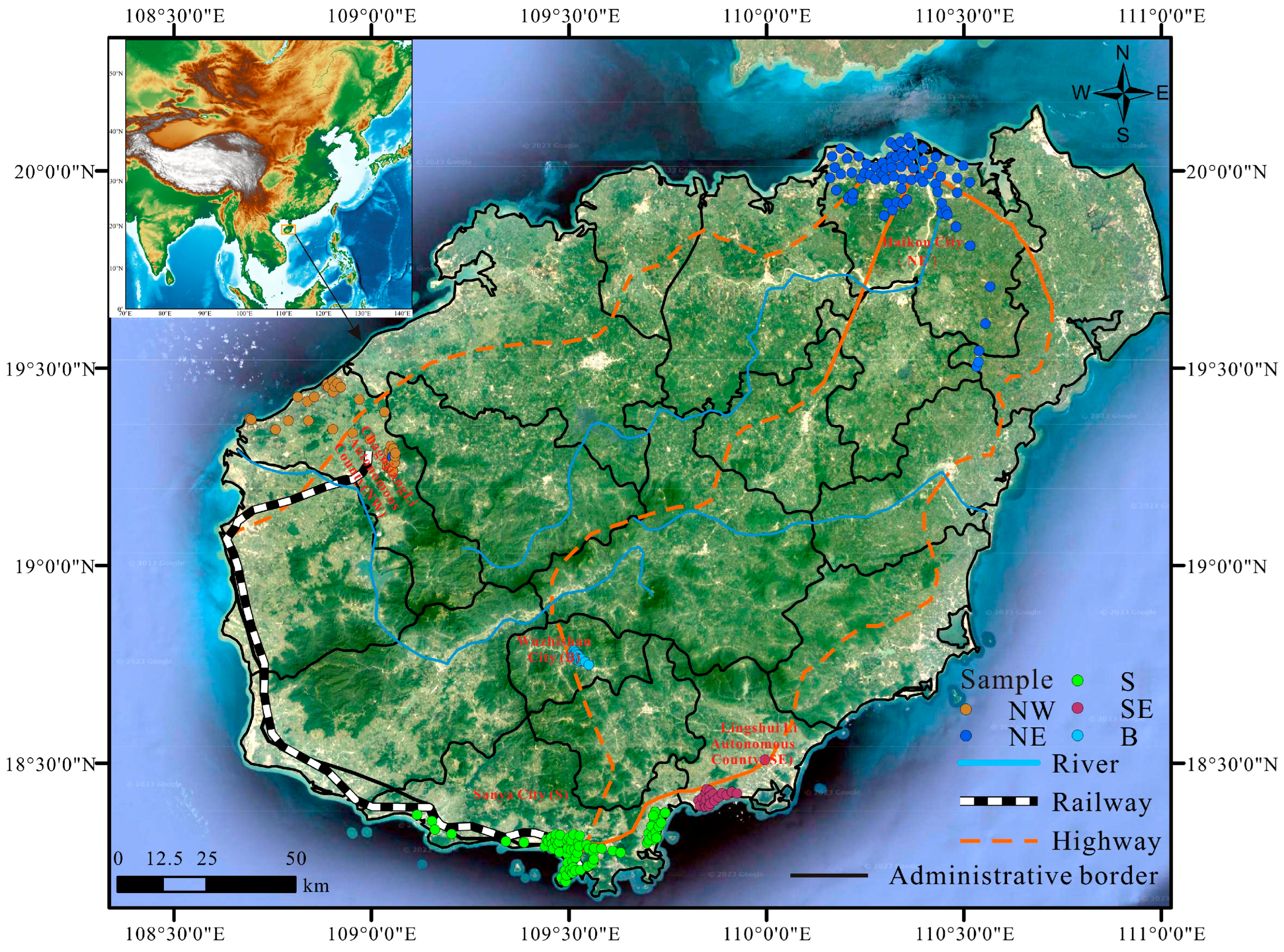
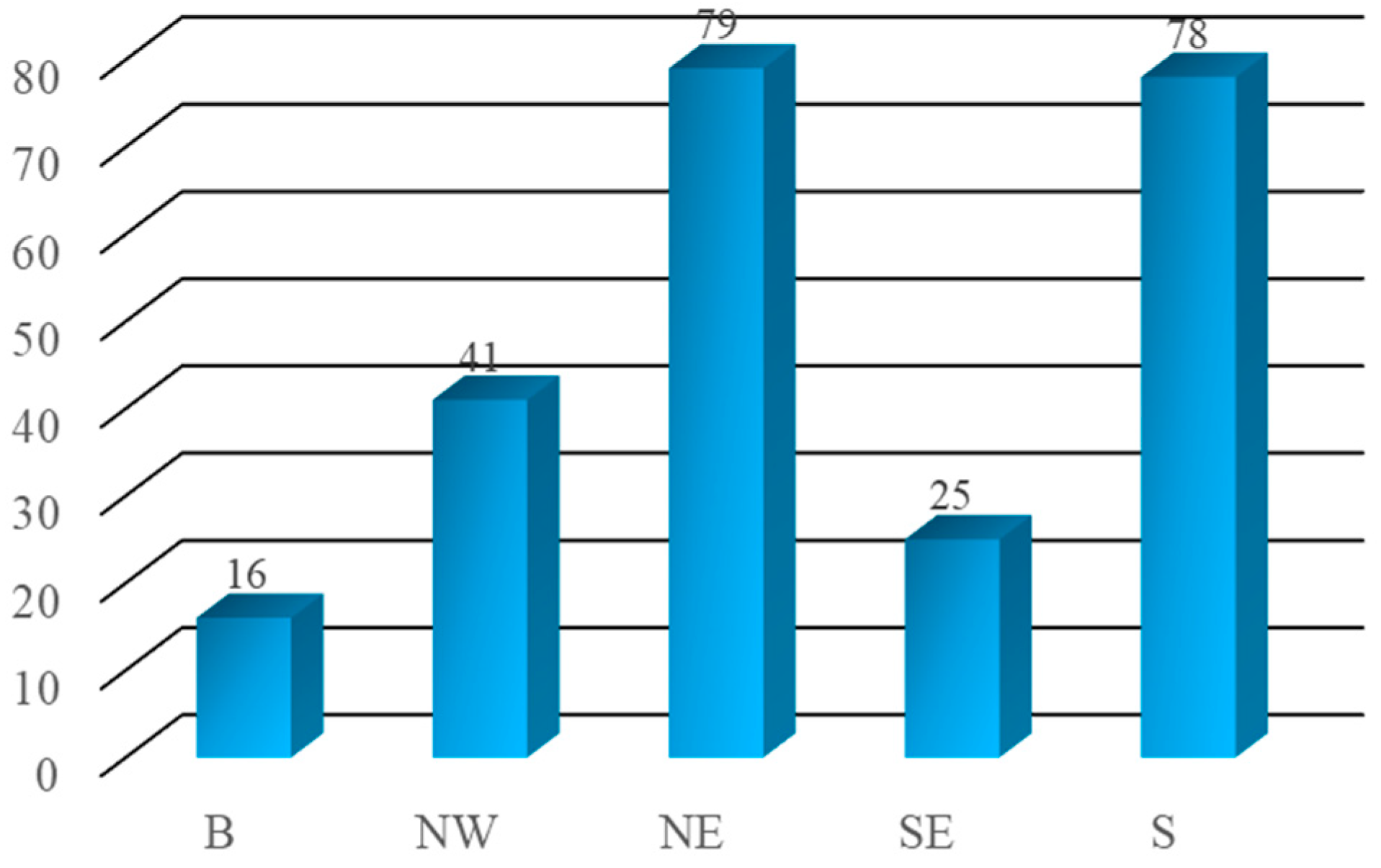
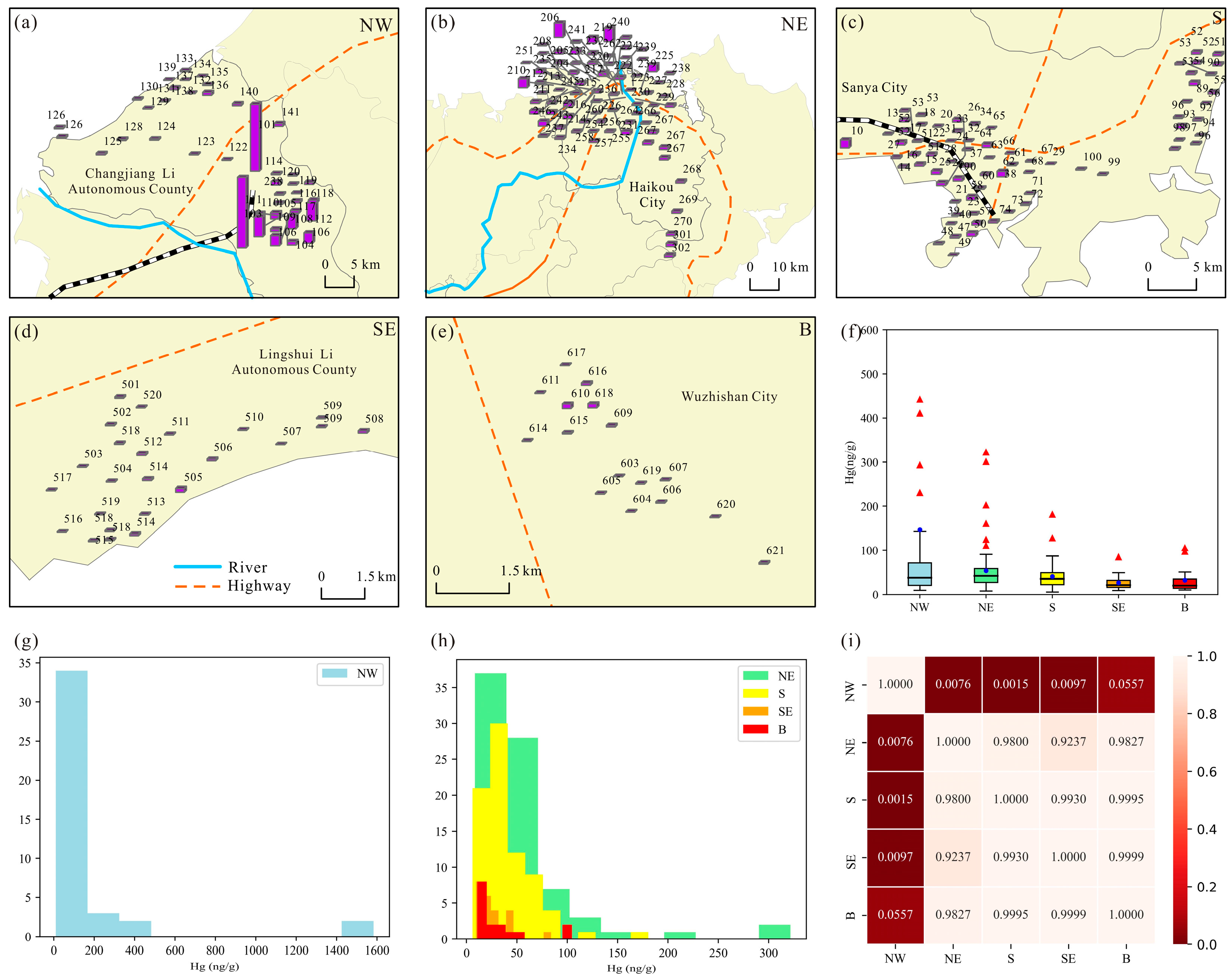
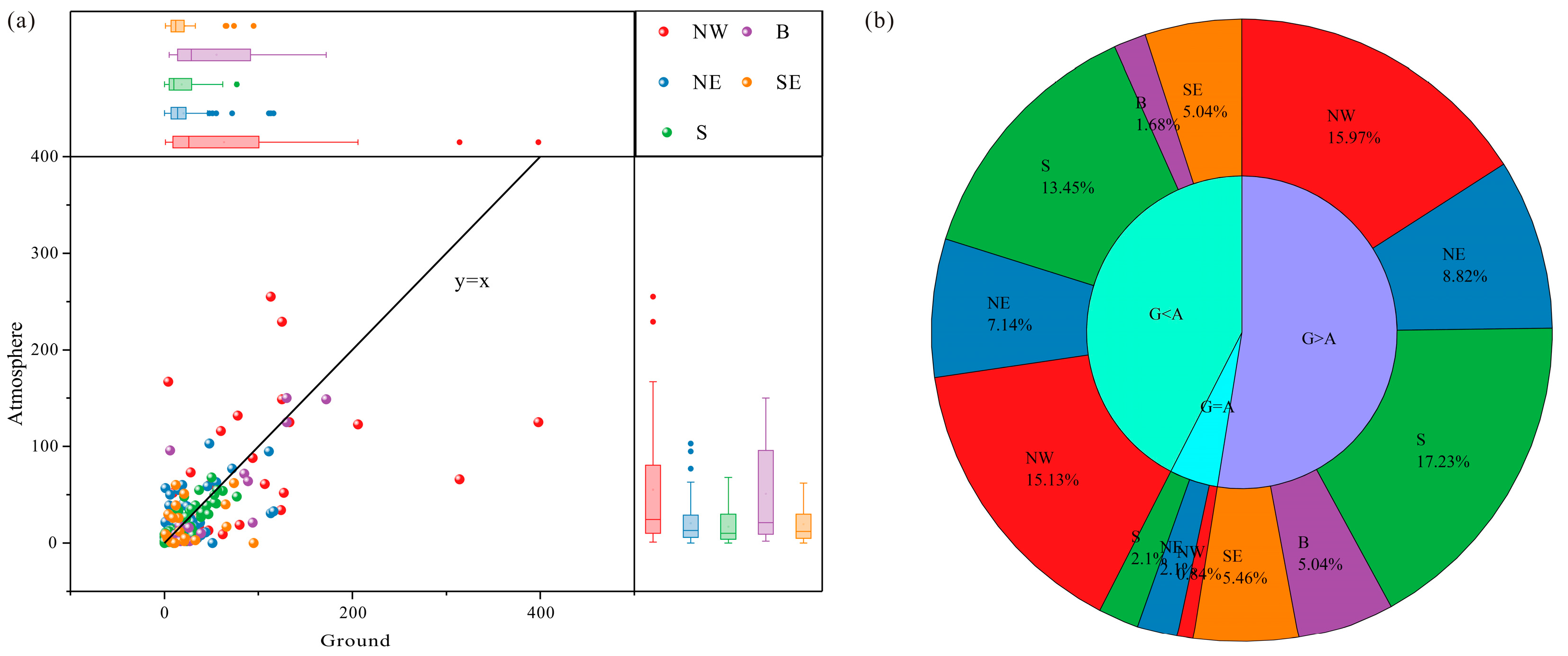
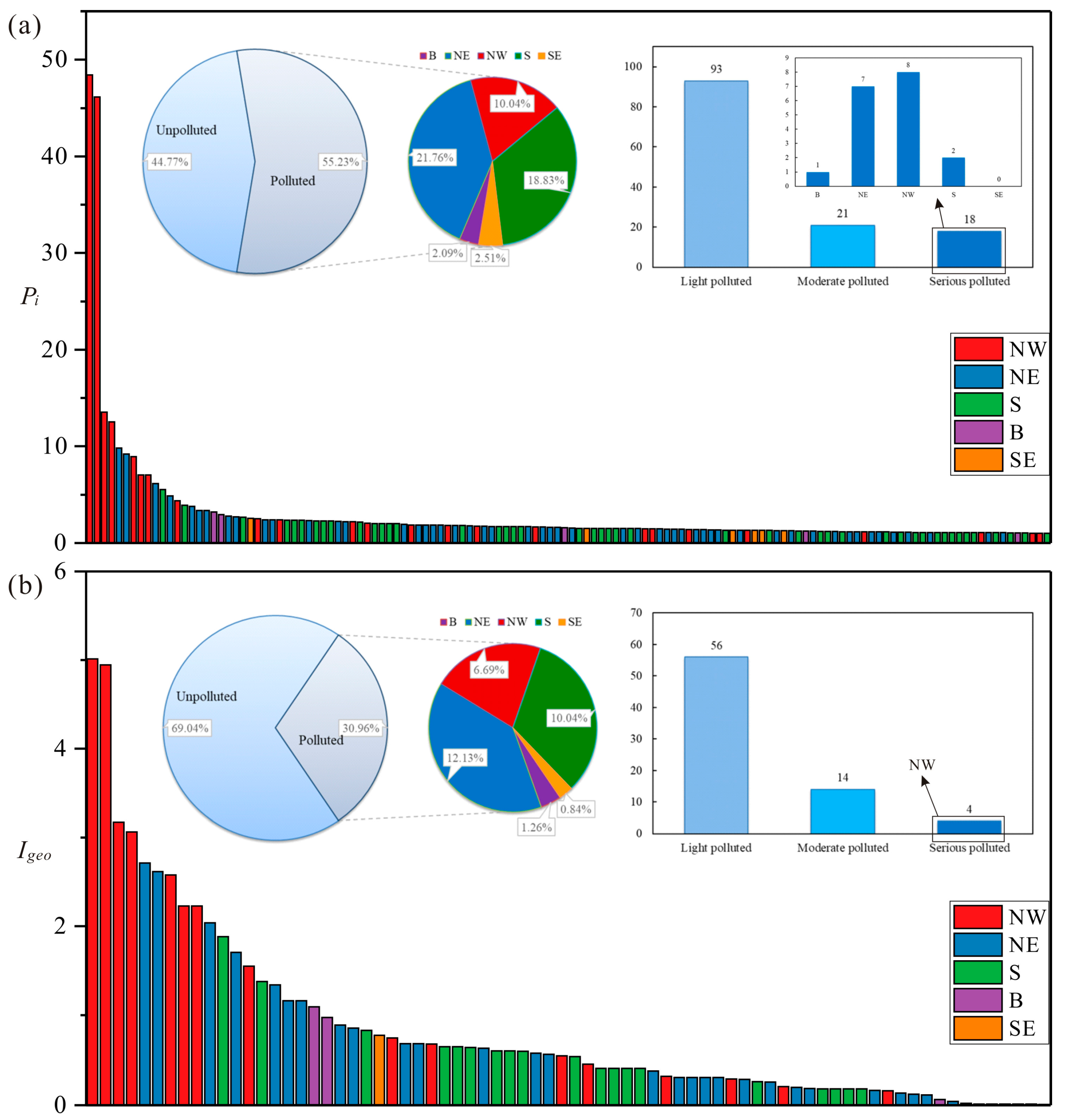

| Sub-Study Area | Mean | Range | Std |
|---|---|---|---|
| B | 32.67 | 10.70–104.67 | 21.61 |
| NW | 147.16 | 10.00–1582.50 | 329.43 |
| NE | 54.01 | 8.33–321.50 | 43.32 |
| S | 41.08 | 6.04–180.50 | 27.25 |
| SE | 26.96 | 9.43–84.00 | 16.52 |
| All | NW | NE | S | SE | B | ||
|---|---|---|---|---|---|---|---|
| All | R2 | 0.613 | 0.495 | 0.488 | 0.827 | 0.173 | 0.797 |
| p | 6.6770 × 10−26 | 0.0010 | 5.1767 | 1.0334 × 10−20 | 0.4078 | 0.0004 | |
| A > G | R2 | 0.830 | 0.829 | 0.740 | 0.931 | 0.788 | 0.802 |
| p | 7.3478 × 10−27 | 3.9269 × 10−5 | 2.4565 × 10−5 | 1.0557 × 10−5 | 0.0023 × 10−5 | 0.1982 × 10−5 | |
| A < G | R2 | 0.789 | 0.786 | 0.752 | 0.928 | 0.516 | 0.932 |
| p | 1.3148 × 10−27 | 2.3977 × 10−5 | 5.0836 × 10−8 | 2.3671 × 10−18 | 0.0708 | 2.9877 × 10−5 |
| All | NW | NE | S | SE | B | ||
|---|---|---|---|---|---|---|---|
| All | R2 | −0.063 | −0.134 | −0.049 | −0.102 | −0.069 | −0.237 |
| p | 0.3348 | 0.4092 | 0.6705 | 0.3755 | 0.7420 | 0.3941 | |
| S > G | R2 | −0.061 | −0.211 | −0.115 | 0.025 | −0.103 | −0.424 |
| p | 0.5455 | 0.4152 | 0.5031 | 0.8923 | 0.7489 | 0.5756 | |
| S < G | R2 | −0.006 | −0.165 | −0.028 | −0.152 | −0.158 | −0.041 |
| p | 0.9512 | 0.4737 | 0.8664 | 0.3413 | 0.6070 | 0.8997 |
Disclaimer/Publisher’s Note: The statements, opinions and data contained in all publications are solely those of the individual author(s) and contributor(s) and not of MDPI and/or the editor(s). MDPI and/or the editor(s) disclaim responsibility for any injury to people or property resulting from any ideas, methods, instructions or products referred to in the content. |
© 2024 by the authors. Licensee MDPI, Basel, Switzerland. This article is an open access article distributed under the terms and conditions of the Creative Commons Attribution (CC BY) license (https://creativecommons.org/licenses/by/4.0/).
Share and Cite
Sun, Y.; Yang, C. Soil Mercury Pollution of Hainan Island, China: Patterns, Influencing Factors, and Health Risks. Sustainability 2024, 16, 3083. https://doi.org/10.3390/su16073083
Sun Y, Yang C. Soil Mercury Pollution of Hainan Island, China: Patterns, Influencing Factors, and Health Risks. Sustainability. 2024; 16(7):3083. https://doi.org/10.3390/su16073083
Chicago/Turabian StyleSun, Yan, and Canchao Yang. 2024. "Soil Mercury Pollution of Hainan Island, China: Patterns, Influencing Factors, and Health Risks" Sustainability 16, no. 7: 3083. https://doi.org/10.3390/su16073083
APA StyleSun, Y., & Yang, C. (2024). Soil Mercury Pollution of Hainan Island, China: Patterns, Influencing Factors, and Health Risks. Sustainability, 16(7), 3083. https://doi.org/10.3390/su16073083








